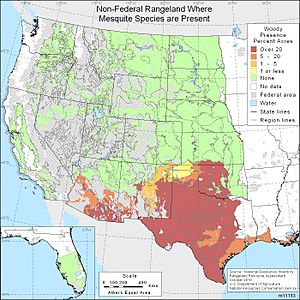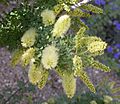Mesquite facts for kids
Mesquite is a common name for many plants in the Prosopis family. There are over 40 different kinds of these small, bean-producing trees. They naturally grow in dry areas of the Americas.
Mesquite trees have very long roots. These roots help them find water deep underground. Since they are legumes, mesquites help put nitrogen into the desert soil. This is important for other plants to grow. These trees usually bloom from spring to summer. They often grow fruits called "pods."
Prosopis trees can grow up to 8 meters (about 26 feet) tall. Their height depends on where they grow and the weather. They lose their leaves in certain seasons. They can have either deep or shallow roots, depending on the rainfall. Mesquite trees live a long time. Young mesquite plants can also survive well with little light and during dry times. The Cahuilla people, who are native to North America, used to eat mesquite seeds.
Contents
The History of Mesquite Trees
Prosopis trees have been in North America for a very long time, since the Pliocene era. Scientists have found mesquite wood that is 3,300 years old. People think these trees grew alongside large animals in the New World.
When many large animals disappeared long ago, mesquite trees found new ways to spread their seeds. One idea is that their fruit pods attracted other animals to help spread the seeds. Later, when people brought livestock like cows, these animals also helped spread mesquite seeds into grasslands. Another idea is that mesquite trees were always in grasslands. But regular fires stopped them from growing and spreading their seeds before livestock arrived.
What Does the Word "Mesquite" Mean?
The English word "mesquite" comes from the Spanish word mezquite. This Spanish word came from the Nahuatl language, where the word was mizquitl.
Where Mesquite Trees Grow
Mesquite trees can grow as small shrubs in shallow soil. But in deep soil with enough water, they can grow as tall as 15 meters (about 50 feet). They form a round top that can be almost as wide as the tree is tall. They might have one main trunk or many branches.
Their leaves are light green to blue and made of many small leaflets. These leaves create light or deep shade, depending on the type of mesquite. In spring and summer, they grow spikes of flowers. These flowers turn into flat bean pods that are 5 to 15 centimeters (2 to 6 inches) long. Many kinds of mesquite trees have thorns. Even if a mesquite tree is cut down to the ground, it can often grow back.
How People Use Mesquite
Once the mesquite pod is dry, the whole pod can be eaten. It can be ground into mesquite flour and used to make bread.
Mesquite trees are native to the United States. Their wood can be used as lumber. Early Spanish explorers used mesquite wood to build ships. Today, it is often used for fancy rustic furniture and cabinets. Smaller pieces of mesquite wood are popular for smoking food in the Southern United States.
During the summer, you might find red-orange sap on mesquite branches. People who lived in the desert used this sap for medicine. They put the sap on burns and cuts to help them heal faster. They also gargled a mix of water and sap to help sore throats. This same mix was also said to help with upset stomachs.
Mesquite as an Invasive Plant
Honey mesquite has been brought to parts of Africa, Asia, and Australia. The World Conservation Union sees it as one of the world's most difficult invasive species. Its spread into grasslands is mostly due to farm animals. Other reasons include climate change, too much grazing by animals, and fewer fires.
Even though Prosopis trees grow naturally in some areas, these changes have helped them grow much faster than other native plants. They are now considered invasive because they can take over weak ecosystems.
Prosopis trees are unusual because they are very invasive in both their native homes and new places. When they invade an area, they change how water, energy, and nutrients move through the ecosystem. They also affect the variety of plants and animals and how much plant life grows. How dense the mesquite trees are and how much shade they create affect the grasses and native shrubs around them.
In the United States, Prosopis has become the main woody plant on 38 million hectares (about 94 million acres) of dry grasslands. North America is its native home, but a problem in the ecosystem has allowed it to spread quickly. It is seen as the most common "pest" plant in Texas. About 25% of Texas' grasslands are taken over by mesquite. About 16 million acres are so full of mesquite that it stops most grass from growing. In Mexico and the US, the two biggest problem species are honey mesquite (Prosopis glandulosa) and velvet mesquite (Prosopis velutina).
Australia is also affected by Prosopis trees. Especially P. pallida, P. glandulosa, P. velutina, and their mixes with P. juliflora. Prosopis trees are ranked as one of Australia's 20 most serious weeds. They now cover almost 1 million hectares (about 2.5 million acres) of land. Prosopis trees were first brought to Australia to help stop soil from washing away because of their deep roots. They also provided wood and food pods for people. Since Australia is a hot and dry place, Prosopis trees have been able to spread widely.
The last known P. laevigata trees in Australia were removed in 2006. But because seeds might still be in the soil, Biosecurity Queensland waited 15 years. In 2021, they said Australia was free of P. laevigata.
In India, mesquite was brought in many decades ago. But only recently have its effects been studied. This plant has been pushing out the Indian wild ass (Equus hemionus khur). This animal eats the mesquite pods, which was one reason the plant was brought there. By eating and then spreading the seeds, the Indian wild asses help the mesquite grow. The 5,000 square kilometer (about 1,930 square mile) Indian Wild Ass Sanctuary is seeing mesquite spread by about 1.95 square kilometers (0.75 square miles) each year.
By taking over the land, the thick mesquite trees stop native plants from growing. They have also made watering holes hard for animals to reach. This lack of food and water is forcing the endangered Indian wild ass into human areas and farm fields. Farmers try to keep these animals away from their crops.
How to Control Mesquite
Controlling mesquite is hard. One common way is to cut the plants. This works well if the stems are cut at least 20 centimeters (about 8 inches) underground. Another way is to use special chemicals called herbicides. These can be put on individual plants. Putting the chemical at the base of the plant works for all sizes of mesquite. Spraying the leaves works best for plants smaller than 1.5 meters (about 5 feet).
Another way to control mesquite is with fires. Some types of mesquite are easily killed by fire, while others can survive it. For those that are sensitive to fire, this method can be very good. But for those that can survive fire, very hot and strong fires are needed. In Australia, scientists are trying to use insects to control mesquite. They have brought in several insects. The most helpful one for reducing large numbers of mesquite plants is the leaf-tying moth (Evippe).
The best way to manage Prosopis, both where it's native and where it's been introduced, is to target many plants at once. This can be done with herbicides or by removing them physically. Also, scientists are using satellite and aerial images to see how much land mesquite covers. This helps them decide which areas to focus on for control.
Types of Mesquite
- Prosopis alba (white mesquite)
- Prosopis cineraria
- Prosopis chilensis (Chilean mesquite)
- Prosopis glandulosa (honey mesquite)
- Prosopis humilis
- Prosopis juliflora
- Prosopis laevigata (smooth mesquite)
- Prosopis nigra (black mesquite)
- Prosopis pallida
- Prosopis pubescens (screwbean mesquite)
- Prosopis reptans (tornillo)
- Prosopis strombulifera (creeping mesquite)
- Prosopis velutina (velvet mesquite)
Gallery
-
Screwbean pods
See also
 In Spanish: Mezquite para niños
In Spanish: Mezquite para niños









